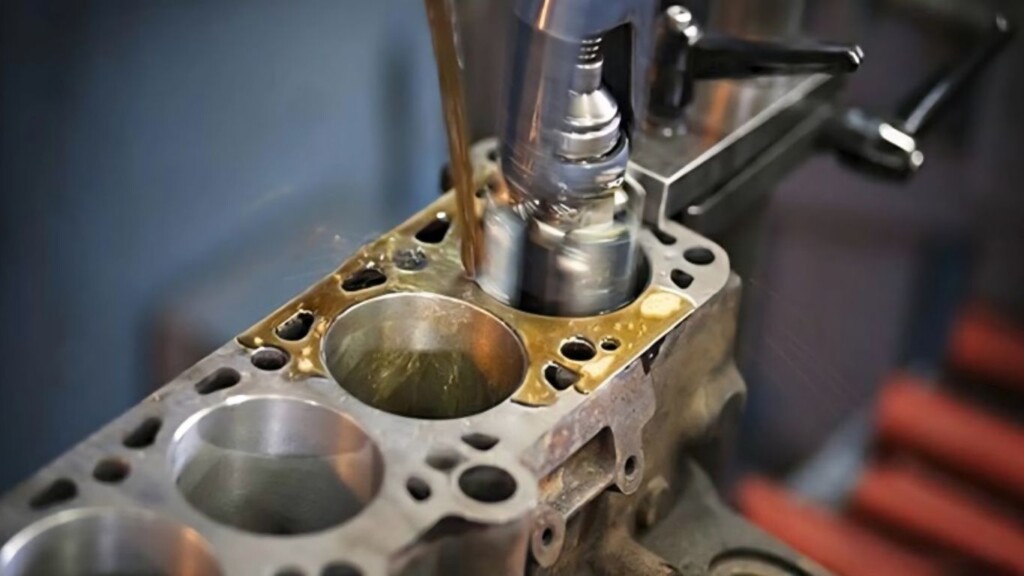
Precision machining is no longer just about removing material, it’s about controlling tolerances at the micron level, achieving mirror-like finishes, and extending tool life while maintaining operational efficiency. Among the many finishing techniques, honing is one of the most crucial processes for ensuring performance-critical components meet their stringent specifications. And at the heart of effective honing lies the correct selection of honing oil.
One such high-performance solution is PAL GRINDHONE, an advanced honing oil developed for both ferrous and non-ferrous applications where dimensional accuracy and superior finish are non-negotiable.
What is Honing?
Honing is a precision surface-finishing process that uses abrasive stones to remove minute amounts of material from the interior of cylindrical components. It is designed to correct geometric deviations such as taper, waviness, or out-of-roundness, and to improve surface texture, typically to achieve a roughness value (Ra) below 0.2 μm.
Unlike grinding, honing allows for precise control of material removal under minimal pressure, making it ideal for applications where high-accuracy alignment and low surface roughness are required. The honing tool oscillates while rotating, producing a crosshatch pattern that aids in oil retention and wear resistance of moving parts.
Key Applications of Honing
Honing is widely used in industries that demand high functional reliability and durability. Typical applications include:
- Automotive: Cylinder liners, crank bores, valve guides, fuel injector sleeves
- Aerospace: Actuation bores, hydraulic cylinders, bearing housings
- Hydraulics: Pump cylinders, piston sleeves, fluid control systems
- General Engineering: Gear bores, bushings, compressor blocks, molds
- Tool and Die: Precision cavities requiring high geometric accuracy
In all these sectors, honing ensures that components operate with minimal friction, optimal sealing, and extended service life.
Why Honing Oil is Essential
While honing stones and machines perform the mechanical work, it is the honing oil that enables the process to function effectively. It plays a multifaceted role:
- Lubrication: Reduces friction between abrasive and workpiece, preventing stone glazing
- Cooling: Dissipates heat generated during honing to avoid thermal distortion
- Debris Removal: Suspends and flushes out fine particles and swarf from the cutting zone
- Tool Preservation: Maintains abrasive sharpness and prolongs stone life
- Surface Integrity: Helps in achieving consistent finishes and dimensional tolerances
- Corrosion Protection: Prevents oxidation on newly machined surfaces
Neglecting the quality of honing oil can lead to poor finishes, rapid tool wear, increased cycle times, and rework.
Impact of Different Products on the Honing Process
Different honing oils can produce dramatically different outcomes depending on their formulation. Low-quality or mismatched oils may result in:
- Inadequate flushing, leading to swarf accumulation and surface scoring
- Increased friction, which shortens abrasive stone life and causes thermal expansion
- Oil staining or residue, especially with sensitive materials like aluminum or nickel alloys
- Non-uniform finishes, due to inconsistent lubricity or incompatible viscosity
In contrast, high-quality products like PAL GRINDHONE are specifically engineered to mitigate these issues. Its chlorine-free, ester-based formulation provides excellent lubricity, thermal stability, and flushing characteristics, making it suitable for even the most demanding honing operations.
When to Use Which Oil
Different applications call for different honing oil formulations. Here’s how you should approach it:
- For hardened steels and bearing alloys, use high-lubricity oils with EP additives to reduce wear and ensure smooth cutting.
- For non-ferrous materials like aluminum or brass, opt for light, non-staining oils that won’t cause chemical discoloration.
- For nickel alloys or superfinishing tasks, choose oils like PAL GRINDHONE that offer excellent flushing action and wetting performance.
- For general-purpose honing, a mineral-based oil with balanced viscosity can provide reliable all-around performance.
PAL GRINDHONE fits exceptionally well in high-precision applications where dimensional control and surface finish are critical, such as in automotive, aerospace, and superfinishing of alloy components.
Key Factors to Consider When Choosing a Honing Oil
Choosing a honing oil is not a matter of convenience, it’s an engineering decision. The following criteria must be evaluated:
- Material Compatibility: Ensure the oil does not chemically interact with or stain the substrate
- Abrasive Type: Compatibility with diamond, CBN, or vitrified abrasives matters
- Oil Viscosity: Influences flow behavior, chip evacuation, and cooling performance
- Lubricity and Additives: Oils should contain performance enhancers like esters or EP agents for demanding operations
- Stone Life Extension: Oils that minimize loading and wear on abrasives improve tool economy
- Environmental & Operator Safety: Chlorine-free and low-misting formulations are ideal for regulatory compliance and worker safety
- Machine Design: Oil must be compatible with the machine’s filtration and delivery systems
PAL GRINDHONE meets these criteria by offering low viscosity, excellent wetting characteristics, and multi-metal compatibility, making it a versatile solution for most high-precision environments.
Why PAL GRINDHONE Delivers
PAL GRINDHONE is formulated with advanced ester-based lubricity and no chlorine content, making it both environmentally responsible and highly effective. It offers:
- Superior flushing action to keep abrasives clean and free-cutting
- Outstanding surface finish capability, especially in hardened steels and nickel alloys
- Extended honing stone life, resulting in fewer changeovers and reduced downtime
- Low product usage due to reduced drag-out and efficient wetting
It is highly recommended for applications where a high degree of finish, tight tolerances, and thermal stability are essential. Whether you are honing components for diesel engines, aircraft hydraulics, or superfinishing hardened sleeves, PAL GRINDHONE ensures that performance is never compromised.
Honing is a sophisticated operation, and its success hinges on precision at every level, geometry, surface texture, tool performance, and fluid selection. Honing oil is not just a supporting fluid but a vital process variable. Choosing the wrong oil can lead to measurable losses in efficiency, accuracy, and cost.
PAL GRINDHONE stands as an ideal choice for professionals and industries where excellence is not optional. With its cutting-edge formulation, it ensures optimal tool life, minimal rework, and consistent, high-quality surface finishes.
For those committed to manufacturing precision components, the right honing oil is not a cost, it’s an investment in performance.
For expert advice and high-quality products, don’t hesitate to visit Palco’s Official Website (www.khushianand.com/palco/) or contact directly at the Email: enquiry@palco.co.in & Phone: +91 93117 94519.


